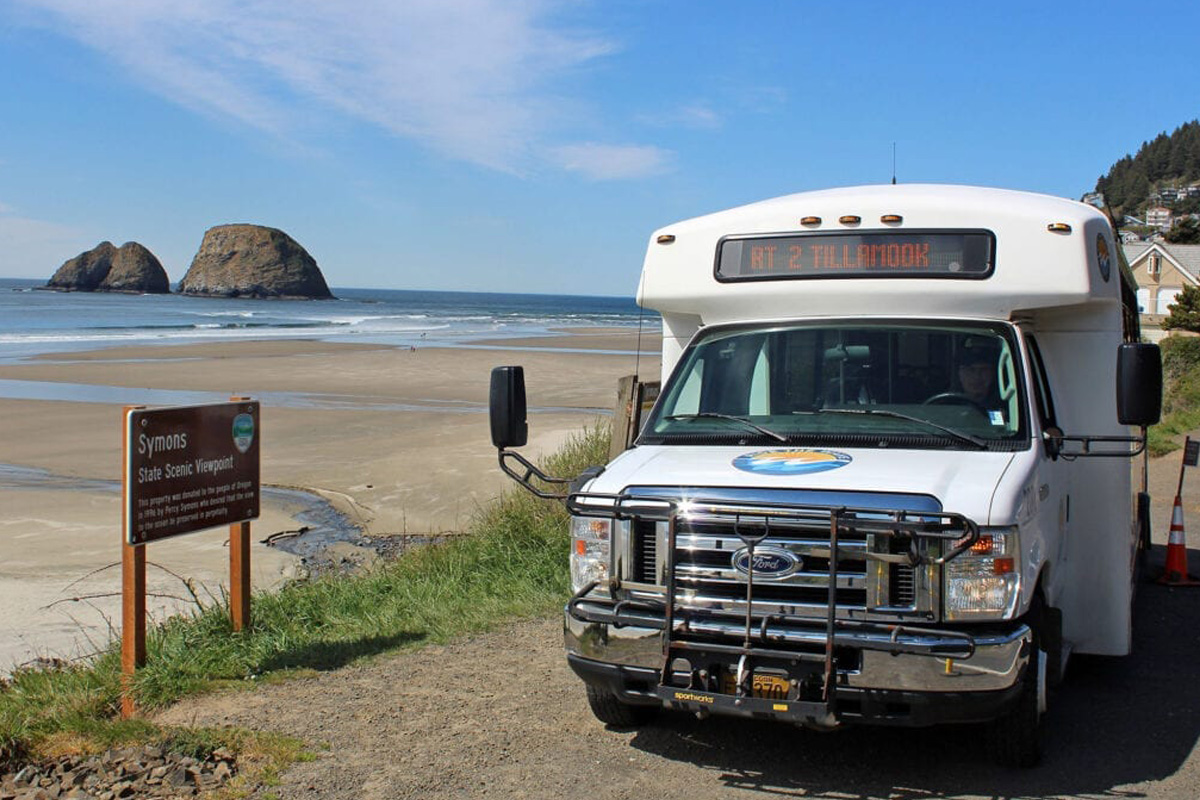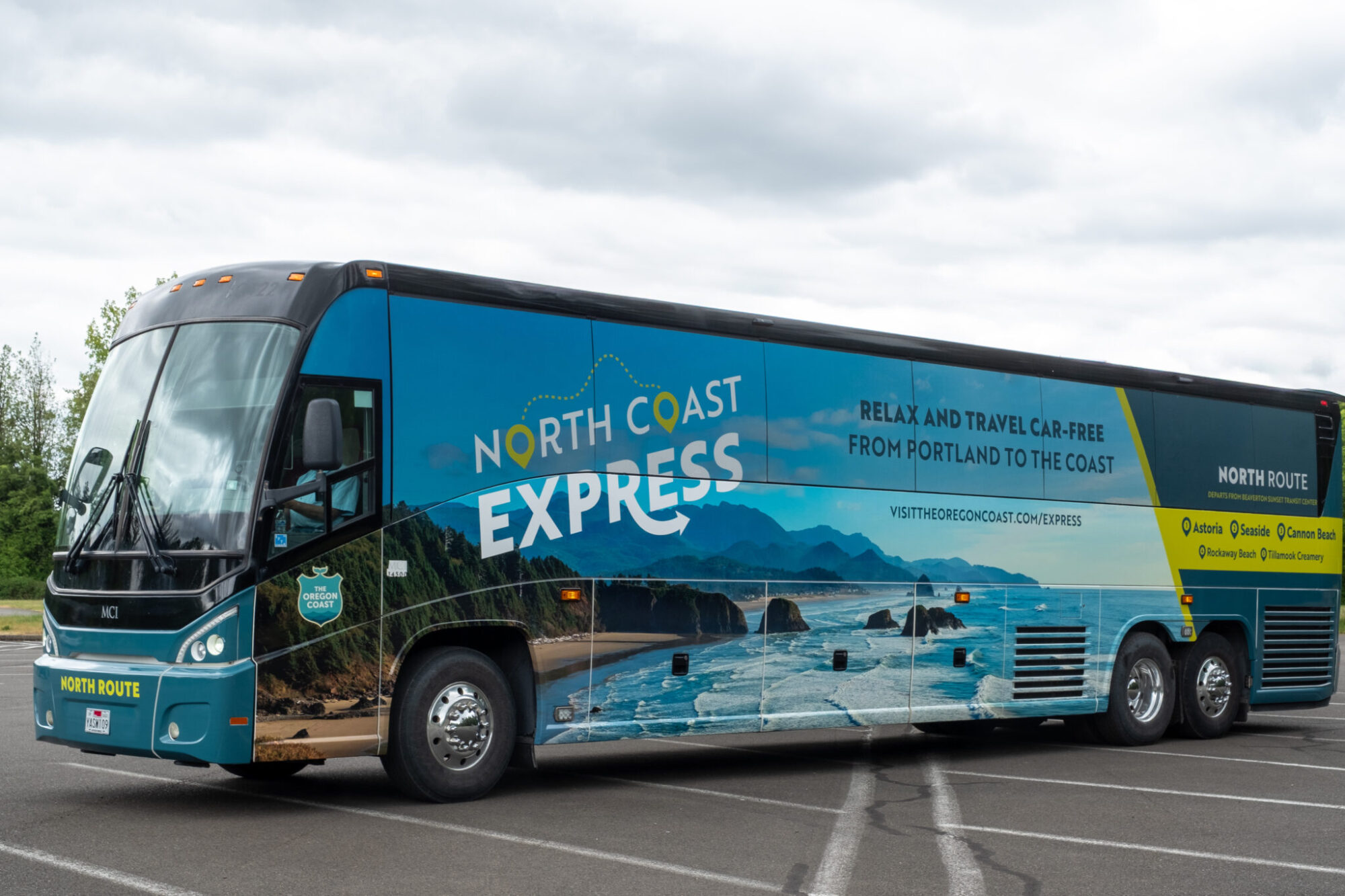Planning an accessible trip starts well before you’re on the road. Luckily, Oregon has a wealth of resources dedicated to accessible travel. This guide breaks down how to plan an accessible trip along the Oregon Coast, from pre-trip logistics and lodging tips to accessible trails, beaches, and attractions.

Accessible Transportation on the Oregon Coast
Getting to the Oregon Coast
Major airports lie just inland of the Oregon Coast. Depending on if you’re traveling to the North, Central, or South Coast, you might fly in to Portland International Airport (PDX), Eugene Airport (EUG), Rogue Valley International Medford Airport (MFR), or Southwest Oregon Regional Airport (OTH).
Check out the accessibility page for PDX and EUG to learn about accommodations offered. While MFR does not have a dedicated accessibility page, guests can request a wheelchair at the terminal, and get sunflower-branded lanyards, pins, and other products in the airport’s administration office on the second floor of the terminal to indicate a hidden disability to staff.
Getting Around the Oregon Coast
By Car
Driving is by far the easiest and most flexible way to explore the Oregon Coast, especially if you’re traveling with mobility aids or specialized equipment. Many travelers bring their own accessible vehicles, but rental options are also available in nearby cities like Portland or Eugene – check out United Access for offerings.

Public Transit
While public transportation is limited along the coast, some regions do offer accessible public transportation:
- North Coast Express: New this summer, the North Coast Express offers a Friday through Sunday service between Memorial Day and Labor Day from Portland to Astoria, Seaside, Cannon Beach, Rockaway Beach, and the Tillamook Creamery.
- POINT Bus: The POINT NorthWest Route offers daily bus service between Portland and Astoria.
- NW Connector: NW Connector is a network of regional buses connecting the North and Central Oregon Coast from Astoria to Yachats. All vehicles are accessible. For more assistance, contact the accessibility office in the region you will be visiting: between Astoria and Cannon Beach, Tillamook County, or Lincoln County.
- Dial-A-Ride services: Dial-A-Ride is a door-to-door shared transportation service available to everyone, and at a reduced fare for those with disability. Schedule your ride in advance with the local transportation service: Sunset Empire Transportation District, Tillamook County Transportation District, Lincoln County Transit, Coos County Area Transit, and Curry Public Transit.
Parking and Navigation
Almost every state park and beach town provides accessible parking spots, but they fill up quickly during weekends and holidays. Traveling midweek or arriving early can help avoid crowds.
For broader navigation and planning help, apps and websites like Wheel the World, AccessNow, Wheelmap, and Google Maps (with the “wheelchair accessible” route feature) are great for identifying step-free entrances, curb ramps, and accessible restrooms in unfamiliar towns.
Accessible Lodging on the Oregon Coast
From cozy oceanfront inns to forest-surrounded yurts, the Oregon Coast offers accommodations for every style. Here’s how to find which are equipped with accessibility features.
Wheel the World
Wheel the World is one of the top places to look for accessible travel recommendations. The platform offers a comprehensive booking system for accessible accommodations, activities, and multi-day trips. Each listing includes detailed accessibility information, such as measurements, photos, and specific features like roll-in showers or step-free entrances, ensuring travelers can make informed decisions.
Wheel the World has partnerships with many coastal communities, including Astoria-Warrenton, Coos Bay-North Bend-Charleston, Newport, Florence, Yachats, Depoe Bay, Lincoln City, Waldport, and Tillamook. Simply click on the coastal community you would like to visit and navigate to “Hotels” in the menu to find accessible accommodations in the area.
Hotels & Inns
Most larger hotel chains in coastal towns like Newport, Florence, Cannon Beach, and Seaside have accessible rooms with roll-in showers, wide doorways, grab bars, and elevator access. Boutique hotels like The Coho Oceanfront Lodge in Lincoln City and Hallmark Resort in Cannon Beach also offer accessible rooms and stellar views. If you are traveling with a pet, check out the Top Dog-Friendly Hotels on the Coast.
Vacation Rentals
Accessible vacation rentals are easy to find by using Becoming Rentable‘s listings. Platforms like Airbnb and Vrbo allow filtering for accessibility features:
- On Airbnb: Click “Filters,” scroll to “Accessibility features,” and select options like step-free entrances or accessible bathrooms.
- On Vrbo: Use “More Filters” and select from “Wheelchair accessible” or “Elevator.”
While these filters are helpful, always confirm details (such as entrance width or bathroom layout) by messaging the host directly. Request recent photos or measurements for peace of mind.
Camping & Yurts
Oregon State Parks like Beverly Beach, Fort Stevens, and Cape Lookout offer accessible yurts and campsites. Many have paved paths to restrooms, accessible fire rings, and close parking. Yurts are a fun middle ground between roughing it and glamping, offering warmth, beds, and power outlets. To find accessible camping options, visit Oregon State Parks, click on “Camping & Lodging,” and check the “Accessibility Features” box.
Accessible Dining and Shopping on the Oregon Coast
Most coastal towns have charming downtowns with a mix of modern and historic buildings. While older architecture can pose challenges, many businesses are upgrading to meet accessibility standards.
Accessible Restaurants
Wheel the World is helpful in identifying verified accessible restaurants. Visit the landing page of the coastal community you would like to visit and navigate to “Restaurants” in the menu.
In Florence, try Waterfront Depot for seafood and views with accessible entry. In Lincoln City, Kyllo’s Seafood & Grill has an elevator and accessible parking. Cannon Beach’s Public Coast Brewing is another welcoming spot with ramp access and roomy indoor seating.
Markets and Shops
Farmer’s markets in towns like Astoria, Newport, and Bandon typically have level paths, open-air booths, and spacious layouts, making navigation easier for those using mobility aids. These markets often take place in public parks or paved downtown areas, which helps reduce tripping hazards and makes for a more relaxed browsing experience.
Many coastal towns also have charming gift shops, galleries, and bookstores—often housed in single-story buildings. Some have step-free entries and wide aisles. Seaside and Florence in particular have walkable downtown areas where businesses are clustered and sidewalks are generally smooth and well-maintained. Larger shops, art co-ops, and national retailers in towns like Lincoln City or Coos Bay typically follow modern accessibility standards, including designated parking and automatic doors. Tools like Google Street View and AccessNow can help scout out entrances and layouts in advance.
Things to Do
There is no shortage of things to do on the Oregon Coast, and the Oregon Coast Visitors Association has curated resources to help travelers with differing abilities navigate the options. Check out Accessible Adventures on the Oregon Coast and Travelability on the Oregon Coast for information on available assistive devices, accessible fishing piers, kayak launches, and more. Once you decide where your adventure will be, browse local recommendations for accessible experiences on the North, Central, and South Coast. Travel Oregon also provides accessibility spotlights and travel suggestions.
Wheel the World is helpful in finding accessible excursions. Go to the landing page of the coastal community you would like to visit and navigate to “Activities” in the menu.
Here are some further resources depending on how you’d like to spend your time on the coast:
Slow Travel
Trails
- Disabled Hikers Trail Guides
- Oregon State Parks Accessibility Guide
- ODFW Guide to Accessible Outdoor Recreation
- U.S. Forest Service Accessible Outdoor Recreation Opportunities
Beaches
Many communities offer fat-tire beach wheelchairs for free through visitor centers or local partners. Some locations even have motorized options available for reservation through David’s Chair.
Final Thoughts
The Oregon Coast is rugged, majestic, and—more and more—welcoming to everyone. While there’s still progress to be made, the growing availability of accessible beaches, trails, lodging, and attractions makes it a top-tier destination for travelers with disabilities.
With a bit of planning and the right tools, you can enjoy tidepool explorations, sunsets over the Pacific, and chowder with a view—all without having to compromise on comfort or inclusion.
So pack your bag and set your sights west. The Oregon Coast is ready for you.